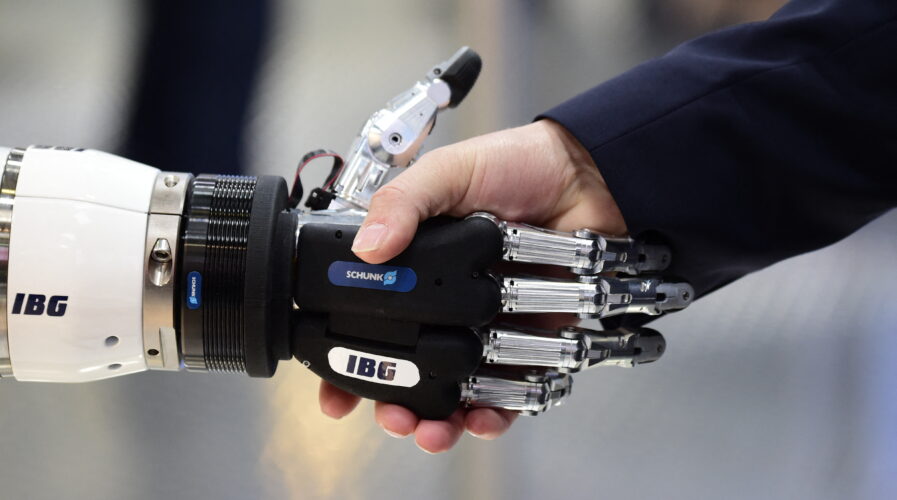
(Photo by Tobias SCHWARZ / AFP)
Emerging as the Hare in 2023 and Beyond – Fighting age-old criticism of automation
Article by Dan Ternes, Chief Technology Officer, APAC, SS&C Blue Prism
We have all heard the criticism that automation is here to replace human workers and take over our jobs. Nothing could be further from the truth. In the latest Randstad Sourceright 2022 talent report, 52% of banking and financial services leaders are using emerging technology to optimize business performance, balancing human touch with technology to perfect customer and employee experience.
Forward-looking organizations and leaders– or hares – strike that delicate balance well, as compared to tortoises. They understand what humans are good at—judgment and evaluation, human interaction, service and engagement, and innovation–and what we are bad at–slavish copying, comparing, updating, and checking. Automation is adopted across various functions and industries to elevate employees’ engagement and augment business operations.
Paving the way for productivity, innovation, and resiliency
Automation is here to stay, and we need it more than ever before. Because the alternative is this: Two-thirds of Singaporean firms are reported to be financially resilient, but not productive or innovative. What IA can do is help organizations achieve all three attributes. Digital workers can be deployed round-the-clock to bring about error-free work and reduce turn-around time. This frees up employees’ time and effort in completing laborious and routine tasks. While productivity is vastly improved, they can now focus on higher-value tasks surrounding innovation and revenue generation.
With digital ecosystems reshaping how services are discovered, assessed, purchased, and delivered, an intelligent automation (IA) platform that is scalable, simple and stable can empower organizations to have a greater ability to push new products to market, improve productivity and create positive customer experience.

Dan Ternes, Chief Technology Officer, APAC, SS&C Blue Prism
Improving the ways of working with IA
Asia Pacific’s ICT spending is expected to grow at a compound annual growth rate (CAGR) of 5.2% and reach US$1.4 trillion by 2026. By 2026, 90% of regional enterprises will combine human expertise with artificial intelligence (AI), machine learning (ML), natural language processing (NLP), and pattern recognition to augment foresight across the organization, making workers 30% more productive and effective.
When the Thai government introduced policies to alleviate financial stress during the pandemic, the nation’s oldest financial institution Siam Commercial Bank (SCB) was met with an overwhelming number of applications to process. Employees were working seven days a week to clear the backlog. Within four weeks of deploying IA, over 100,000 applications were processed, taking significant pressure off employees. With better management of business processes, SCB is able to optimize employees’ time at work and offer efficient and timely customer engagement.
Ultimately, IA helps organizations to achieve many of their key business objectives, whether that is increased competitiveness, accelerated growth, or greater customer and employee satisfaction. In fact, IA capabilities have led to a twofold return on investment (ROI) increase for businesses while also improving their employee experience by 52%.
Making the case
Regardless, the assessment determines whether automation is seen to be a revenue-generating element and competitive differentiator, or simply an expense line-item in the monthly budget.
With the erratic nature and tight financial outlook of businesses today, it might be best to focus on shorter-term returns on a few processes to make the first case. The ambition is to go further and scale automation. By sustaining and extending the use of automation, organizations can reap the longer-term strategic potential of much larger financial savings as well as further their competitive advantage and innovation.
The world today is facing a series of disruptive forces, from inflationary pressure and supply chain disruptions to geopolitical tensions and a shortage of skilled talent in info-communication technology (ICT). Any business downtime in this fragile landscape will be costly. Contrary to being a job replacement, IA is here to transform the work that we do and helps companies to keep pace with the ever-changing landscape.
As more hares look to thrive in today’s ever-changing and competitive business landscape in 2023 and the years ahead, emerging technologies such as Intelligent Automation will not only help businesses to optimize operations for agility and resiliency but also spur innovation, deepen customer relationships, and create an enjoyable work environment for employees.
The views in this article is that of the author and may not represent the views of Tech Wire Asia.
READ MORE
- Safer Automation: How Sophic and Firmus Succeeded in Malaysia with MDEC’s Support
- Privilege granted, not gained: Intelligent authorization for enhanced infrastructure productivity
- Low-Code produces the Proof-of-Possibilities
- New Wearables Enable Staff to Work Faster and Safer
- Experts weigh in on Oracle’s departure from adland


